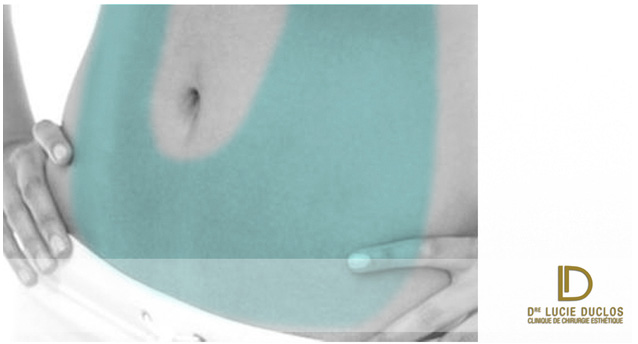This article focuses on two of the most common methods:
> circumferential abdominoplasty and
> Fleur de Lys abdominoplasty.
For people with loose, drooping skin in their abdomen or those whose abdominal muscles are weakened due to pregnancy or weight loss, a tummy tuck may be the best way to achieve a full-figured silhouette. both firm and fine. Although it is not considered a common procedure, abdominoplasty< /strong> can help slim a person’s body when diet and exercise have been ineffective in removing excess tissue and stubborn fat cells.
However, there are several techniques that Dr. Duclos commonly uses, the latter of which achieve better results, particularly from an aesthetic point of view.
Circumferential abdominoplasty
During a tummy tuck or abdominoplasty operation, the plastic surgeon removes loose skin by tightening the abdominal muscles and removing stubborn fat deposits. This proven surgical treatment can meet the specific needs and goals of each patient. During your consultation with Dr. Duclos, she will be able to advise you on the most appropriate technique for your condition. There are several variations of the tummy tuck, each designed to target certain areas of the body or specific problems.
Principle of intervention
A circumferential abdominoplasty is more extensive than the standard procedure. It is usually performed on patients who have lost a lot of weight and as a result have loose skin around their entire body. In this type of operation, Dr. Duclos makes an incision in the lower part of the abdomen which extends towards the hips all around the waist and back to the upper part of the buttocks. This helps remove excess skin and fat and firms the muscles. The outer thighs and buttocks are also lifted and a new navel is created.
Circumferential abdominoplasty: for which patients?
Patients who have a slightly protruding abdomen or a small amount of excess skin around their abdomen are not ideal candidates for a circumferential abdominoplasty. Indeed, this more advanced intervention aims to dramatically change a person’s physique after significant weight loss. Often, this involves the patient being bothered by excess fat and an overabundance of skin in areas that are difficult to tone, such as the abdomen, outer thighs and buttocks. A circumferential abdominoplasty is most often designed to rid formerly obese people of this excess skin and give muscle tone.
Fleur de Lys abdominoplasty
Following weight loss, following a diet or one of the many bariatric procedures designed to lose weight, there is often significant excess skin over the entire abdominal area. In many cases, these patients are best managed with a standard abdominoplasty. In other cases, there is simply too much excess skin, especially around the circumference of the abdomen. Traditional abdominoplasty techniques often fail to adequately correct complex body shape deformities in patients who have experienced massive weight loss. To address these deformities, adding vertical skin resection to traditional horizontal excision has become a popular procedure.
Fleur de Lys type abdominoplasty: for better results
In order to remove enough skin in the horizontal direction, a fleur-de-lis tummy tuck is sometimes necessary. It is very similar to the standard procedure, except that excess skin in the upper abdomen is removed, leaving a vertical scar in the midline of the abdomen. The length of this incision will vary and will not extend to the rib cage or sternum in most cases. Excess skin in the lower abdomen is then removed and the incision closed. Due to this additional scar, this procedure is reserved for very specific patients.
Achievement and objectives of the intervention
A fleur-de-lis tummy tuck is performed under general anesthesia and usually lasts 3 hours. The incisions for a fleur-de-lis tummy tuck are similar to the standard procedure with the incision added in the midline of the abdomen. The method can be performed safely with complication rates comparable to traditional abdominoplasty techniques. Ideal candidates are patients with excessive abdominal skin sagging both horizontally and vertically, which may not be adequately corrected with transverse excision only.
While standard abdominoplasties cannot treat excess raw tissue and laxity, the Fleur De Lys technique takes care of supraumbilical excess. It is a safe, low-complication technique with a high satisfaction rate.
More and more effective techniques
There are a variety of tummy tucks, procedures available and operations can be tailored to the patient’s wishes and needs. Generally speaking, however, tummy tucks are most often used to remove excess skin, unwanted scars, stretch marks and fat, and to tighten the muscles in the abdomen. As mentioned, it sometimes happens that the abdominoplasty is circumferential in order to also remove excess skin all around the waist.
Dr. Duclos also regularly practices the technique called mini abdominoplasty which helps strengthen the muscles and to remove fat and skin through a short scar located opposite the pubis in the lower part of the abdomen. This technique is often useful after a cesarean section.
As for the traditional technique, this allows the surgeon to treat excess skin and fat in a single plane, where the abdominal wall tissue hangs at the waist, although postoperative lateral fullness may be a problem fluent. However, in many patients, weight loss is such that there is excess tissue in the midline and laterally. The vertical midline component of the Fleur-de-Lys abdominoplasty addresses these excess tissues in the vertical plane.
All abdominoplasties result in scarring, although the nature of the scar depends on the technique used. The marks tend to appear more as redness and fade after four to six weeks, progressing over the next six months or so to white. Most patients will have faded scars over time.
Whether it is the technique used e.g. mini abdominoplasty, standard abdominoplasty, Fleur de Lys type abdominoplasty or circumferential abdominoplasty, Dr. Duclos has always been very concerned and sensitive about the quality of scars.
She takes all the means currently available to ensure that they are the finest and most discreet. Among other things, it ensures that their location respects the principle of anatomical zones, for example the abdomen, pubis, thighs and buttocks. The location and shape of the new umbilicus are also very important to Dr. Duclos. Umbilicoplasty must be performed with great care since the navel is in the center of the abdomen. Dr. Duclos also uses the multiple-layer closure technique, which reduces tension on the scar and thus promotes a thin scar. Also, Dr. Duclos uses suture threads whose tensile strength and duration also make it possible to minimize tension on the scar and thus improve the quality of the scar. In addition, Dr. Duclos recommends, in the weeks following the procedure, the use of a healing cream whose effectiveness has been scientifically proven.
The mini abdominoplasty is a variation of the classic abdominoplasty. This procedure aims to tighten or rejuvenate the lower abdomen region only. It consists of removing excess skin and fat from the suprapubic region (below the navel).
The advantage of a mini abdominoplasty is that the incision is made very low on the abdomen, just above the pubis, which means that the scar is very discreet and easily concealed by clothing.


